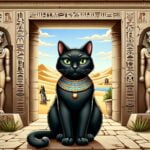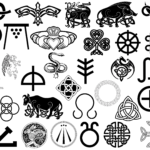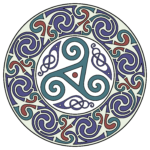Hey there, curious cat! Join us on an epic quest to crack the code of Gaelic symbols, the ancient language of Celtic culture. Dive into the enchanting world of clan crests, mystical deities, and legendary tales woven into these enigmatic emblems. We’ve got you covered with expert insights, in-depth research, and a heap of respect for Gaelic traditions. Get ready to unravel the secrets of these timeless symbols and their enduring legacy in this captivating journey through Celtic history and culture.
Gaelic Symbols: Unraveling the Enigmatic Tales of Celtic Culture
For centuries, people have been fascinated by Gaelic symbols, which offer a glimpse into the captivating heritage and spiritual beliefs of Celtic cultures. From the iconic Celtic cross to intricate knots, these symbols hold deep meanings and intriguing stories that beckon to be discovered.
A Symphony of Symbolism
Gaelic symbols are more than just beautiful designs—they are potent visual representations of profound concepts and values:
- Strength and Unity: The Tree of Life symbolizes our unwavering connection to nature and our shared roots.
- Faith and Spirituality: The Celtic Cross harmoniously blends Christian and Celtic traditions, representing the convergence of two worlds.
- Eternity and Interdependence: Celtic knots depict the unending flow of life and the interconnectedness of all things.
- Growth and Transformation: Spirals reflect the dynamic nature of existence and our ongoing journey of self-discovery.
- Balance and Well-being: The Triskele symbolizes the delicate harmony between the physical, mental, and spiritual realms.
Stories Woven into Symbols
These Gaelic symbols carry tales that are as captivating as their designs:
- The Dara Knot: Its intertwined lines embody the strength and resilience of an ancient oak tree.
- Awen or Three Rays of Light: As a symbol of Neo-Druidism, it represents the power of inspiration and illumination.
- St. Brigid’s Cross: This Christian icon honors Ireland’s patron saint and is associated with protection and healing.
- Green Man: A symbol of nature’s abundance and transformative power, its face emerges from lush foliage.
- Irish Harp: This emblem showcases Ireland’s rich musical legacy and national pride.
Connecting to Our Roots
Gaelic symbols are living testimonies to the enduring spirit of Celtic culture and spirituality. They connect us to our ancestral wisdom and offer insights into their cherished beliefs and values. By exploring the enigmatic language of these symbols, we embark on a journey of understanding, connection, and timeless inspiration.
Expand your understanding of the hidden significance embedded within ancient symbols and their meanings ancient symbols and meanings. Unlock the enigmatic realm of Celtic symbols celtic symbols, including their rich history and cultural significance. Discover the captivating allure of Irish Celtic symbols irish celtic symbols and delve into the enduring legacy of Scottish symbols scottish symbols. Embark on a captivating journey through the timeless wisdom of meaningful ancient symbols meaningful ancient symbols, unlocking their profound messages and exploring their enduring impact on human history.
How have Gaelic Symbols Shaped Celtic Heritage and Folklore?
Picture this: a warrior’s shield adorned with intricate carvings, swirling together like a captivating dance of nature. Or perhaps an amulet around the neck, bearing a symbol that holds a secret meaning, a whispered tale from the past. These are just glimpses of the profound influence Gaelic symbols have had on Celtic art and culture.
Celtic art is like a vibrant tapestry, woven with stories, beliefs, and a deep respect for the natural world. Gaelic symbols, with their mystic origins, have been the brushstrokes that paint this enchanting canvas.
These symbols are more than just pretty designs; they’re doorways into the past, connecting us to the wisdom and traditions of our ancestors. From ancient trees to majestic animals, each symbol holds a piece of the Celtic soul.
The Cycle of Life
Celtic symbols often depict the interconnectedness and cyclical nature of life. The triskel, with its three interlocking spirals, represents this concept beautifully. It reminds us that everything is in flux, always changing yet somehow staying the same.
Nature’s Harmony
The Celts had a deep reverence for nature, and this is reflected in their symbols. Animals like the hare symbolize speed and agility, while the salmon represents wisdom and knowledge. Trees, too, played a vital role, with their roots connecting us to the earth and their branches reaching towards the heavens.
Personal Growth
Celtic symbols also offer guidance for personal growth. The Ogham alphabet, with its intricate tree carvings, represents different qualities and attributes. The oak symbolizes strength, while the birch signifies renewal. By studying these symbols, we can tap into ancient wisdom and find inspiration for our own journeys.
Evolution and Adaptation
Over time, Celtic art evolved, influenced by neighboring cultures like the Romans and Vikings. Some symbols remained constant, like the triskel, while others were adapted or blended with new influences. This rich tapestry created a unique expression of Celtic heritage.
Symbols in the Modern World
Today, Celtic symbols continue to inspire artists and craftspeople. From jewelry to tattoos, they serve as a reminder of our cultural roots and the enduring power of Gaelic tradition.
A Glimpse into Gaelic Symbolism
| Symbol | Meaning |
|---|---|
| Triquetra | Threefold nature (body, mind, spirit) |
| Tree of Life | Connection to nature, growth |
| Celtic Cross | Christianity and pre-Christian beliefs |
| Spirals | Cycles of life, eternity |
| Animals | Specific qualities and attributes (e.g., hare for speed, salmon for wisdom) |
These symbols are not just relics of the past; they’re gateways to a timeless world of Celtic heritage and wisdom. By embracing their meaning, we connect with our ancestors and find inspiration for our own journeys.
What is the significance of the Tree of Life symbol in Gaelic heritage?
In the heart of Gaelic culture, the Tree of Life is a symbol that tells a story of life, the universe, and everything. It’s like a bridge that connects the earth below with the heavens above, bringing together the realms of humans and the divine.
Imagine a tree with roots that burrow deep into the soil, holding it steady and strong. Just like that, the Tree of Life represents our roots and the things that keep us grounded. But it doesn’t stop there – its branches stretch up to the sky, towards the heavens. This represents our dreams, our hopes, and our connection to something bigger than ourselves.
For the Celts, the ancient people of Europe, nature was everything. They believed that everything was linked together, like a web of life. The Tree of Life was a symbol of this web, showing how we’re all part of something greater than ourselves. More than that, it was like a living timeline, reminding them that life is a cycle of birth, death, and rebirth – just like the changing seasons.
In Gaelic myths, the Tree of Life was a big deal. It was like a portal to other realms, a place where gods and spirits hung out. It was also a source of wisdom and knowledge, a place where secrets were whispered and answers were found. And let’s not forget about fertility! In Gaelic culture, the Tree of Life was seen as a symbol of growth and prosperity, a reminder of the earth’s blessings and the promise of a good harvest.
Even today, the Tree of Life is a symbol that sticks with the Gaelic culture. You can see it everywhere, from art to jewelry, to tiny carvings on everyday objects. It’s a reminder of the deep bonds that tie the Gaelic people to their past and a testament to the power of ancient symbols that still resonate with us today.
Remember these key points:
- The Tree of Life is a symbol of strength, roots, and the link between earth and heaven.
- It shows the cycle of life, death, and rebirth.
- The Tree of Life is tied to the World Tree, which connects the heavens, earth, and underworld.
- It represents fertility and abundance.
- The Tree of Life is a symbol that still holds meaning for Gaelic people today.
What are the different meanings associated with the Celtic Cross symbol?
Hey there, curious minds! Let’s dive into the fascinating world of the Celtic Cross, a symbol that’s a melting pot of ancient beliefs and Christian influences. It’s not just a pretty ornament; this cross holds a wealth of hidden meanings that will leave you intrigued and inspired.
The Sun and Eternity: A Circle Within a Cross
Picture this: a circle surrounding the cross. That’s not just any circle; it’s the sun, baby! It’s a symbol of life that keeps going and going, like a hamster on a spinning wheel. It also represents rebirth, because just like when you wake up from a great nap, the sun rises every morning, promising a fresh start.
The Halo of Christ: A Heavenly Glow
Now, let’s talk about the circle in the context of Christianity. It turns into a halo, representing Jesus Christ, the big boss of the Christian faith. It’s like a neon sign above his head, telling us that he’s bringing the light and conquering the darkness.
The Four Evangelists: The Squad of Scribes
Those four arms of the cross aren’t just there for show. They each represent one of the four evangelists: Matthew, Mark, Luke, and John. These guys were like rockstar biographers, telling the story of Jesus like nobody’s business.
The Tree of Life: A Cosmic Connection
Sometimes, the Celtic Cross gets a little arty and shows up with some fancy carvings that look like a tree. It’s a symbol of the Tree of Life, which connects the heavens and the underworld. It’s a reminder that everything’s connected, from the stars in the sky to the worms in the dirt.
Balance and Harmony: A Meeting of Minds
The Celtic Cross isn’t just a Christian symbol; it also represents pagan beliefs. Putting the Christian cross together with the pagan sun wheel is like a peace treaty between two different worlds. It shows that we can all get along, even if our beliefs are as different as Gandalf and Darth Vader.
FAQ
Q1: Where did the term “Gaelic” originate?
A1: The term “Gaelic” is derived from the Goidelic branch of Celtic languages, spoken in Ireland, Scotland, and the Isle of Man.
Q2: What historical events influenced the development of Gaelic symbols?
A2: The rich history of the Celts, including their interactions with neighboring cultures, Christianity, and social changes, shaped the evolution and interpretation of Gaelic symbols.
Q3: How were Gaelic symbols traditionally used?
A3: Gaelic symbols held significant cultural and practical roles, adorning everything from jewelry, clothing, and weapons to monuments, manuscripts, and architectural structures.
Q4: What are some of the most recognizable Gaelic symbols?
A4: The Celtic Cross, Tree of Life, Triskele, Triquetra, and Dara Knot are among the most well-known and widely used Gaelic symbols.
Q5: How can we interpret the meanings of different Gaelic symbols?
A5: Understanding the meanings of Gaelic symbols requires a multifaceted approach, considering historical, cultural, and linguistic contexts, as well as drawing insights from ancient texts, folklore, and archaeological evidence.
- Understand bone yellow: Colorism’s impact on Black communities - April 19, 2025
- Green Natural Sandstone: Eco-Friendly Building Solutions - April 19, 2025
- Red Cross Flag: Protecting Humanity Through History - April 19, 2025

















Comments are closed.